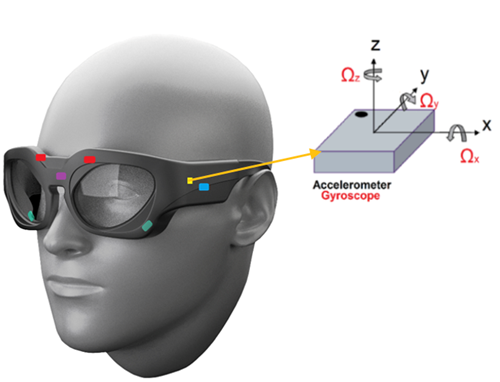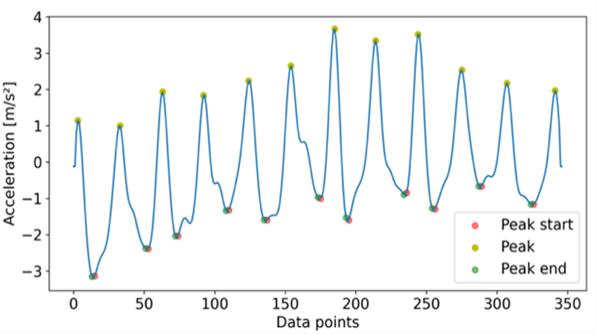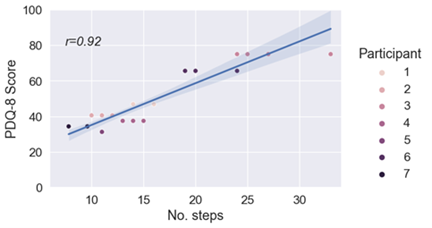Category: Other
Objective: To evaluate the applicability of sensor-enabled smart glasses for remote tracking of symptoms related to Parkinson’s disease
Background: Diagnosis and monitoring of PD by a specialist involve mapping patient reported PD symptoms to experiences of Activities of Daily Living (ADL), using instruments such as UPDRS. Existing wearables for symptom monitoring record motor symptoms of PD in isolation, without contextualizing to ADL, which leads to important information about the disease’s impacts on quality of life being lost. We propose sensor-equipped smart glasses to track ADL and facial expressions in a home setting.
Method: Working towards smart-glasses solutions for remote tracking of PD symptoms (see [figure1]), we performed three studies:
1. 25 healthy participants performed ADL in both simulated and uncontrolled home environments. Using the 9-axis IMU in the smart glasses, we developed a machine-learning method for recognizing ADL.
2. 7 patients with PD with varying levels of symptom severity, performed 35 sessions of the Timed-Up-and-Go test while wearing the glasses. We developed an IMU-based step-detection algorithm (example in [figure2]).
3. 27 healthy participants performed facial expressions varying in intensity, duration, and head movement included. Using the optomyography sensors in the smart glasses, we developed a machine-learning method for recognizing four facial expressions and a neutral state.
Results: 1. The F1-score for recognizing six activities (eating, hygiene, laying, sitting, standing, and walking) was 0.89 and 0.82 in a simulated and uncontrolled environment, respectively.
2. The average number of steps was 15.9 with a SD of 5.45. The average Mean Absolute Percentage Error was 8.1%, which represents an average error of 1.3 steps (out of 15.9). [figure3] presents the correlation coefficients between the Parkinson’s Disease Questionnaire (PDQ-8) and the number of detected steps (r=0.92).
3. The F1-score for recognizing facial expressions (smile, frown, eyebrows raise, squeezed eyes) and a neutral state was 0.90.
Conclusion: Our preliminary findings show the potential of sensor-enabled smart glasses for remote tracking of ADL and facial expressions. We plan to execute a larger study with 100 participants to further demonstrate the feasibility of our approach.
References: 1. GBD 2016 Neurology Collaborators. Global, regional, and national burden of neurological disorders, 1990-2016: A systematic analysis for the global burden of disease study 2016. Lancet Neurol. 2019;18(5):459-480.
2. Global health estimates 2020: Disease burden by cause, age, sex by country and by region, 2000–2019. Geneva: World Health Organization; 2020.bhttps://apps.who.int/iris/bitstream/handble/10665/332070/9789240005105-eng.pdf
3. Chandrabhatla, A. S., Pomeraniec, I. J., & Ksendzovsky, A. (2022). Co-evolution of machine learning and digital technologies to improve monitoring of Parkinson’s disease motor symptoms. NPJ digital medicine, 5(1), 1-18.
4. Spear, K. L., Auinger, P., Simone, R., Dorsey, E., & Francis, J. (2019). Patient views on telemedicine for Parkinson disease. Journal of Parkinson’s Disease, 9(2), 401-404.
5. Riggare, S., Stamford, J., & Hägglund, M. (2021). A long way to go: patient perspectives on digital health for Parkinson’s disease. Journal of Parkinson’s Disease, 11(s1), S5-S10.
To cite this abstract in AMA style:
I. Kiprijanovska, F. Panchevski, S. Stankoski, M. Gjoreski, J. Archer, J. Broulidakis, I. Mavridou, B. Hayes, T. Guerreiro, C. Nduka, H. Gjoreski. Towards smart glasses for improved care of individuals with Parkinson’s disease [abstract]. Mov Disord. 2023; 38 (suppl 1). https://www.mdsabstracts.org/abstract/towards-smart-glasses-for-improved-care-of-individuals-with-parkinsons-disease/. Accessed December 18, 2025.« Back to 2023 International Congress
MDS Abstracts - https://www.mdsabstracts.org/abstract/towards-smart-glasses-for-improved-care-of-individuals-with-parkinsons-disease/



